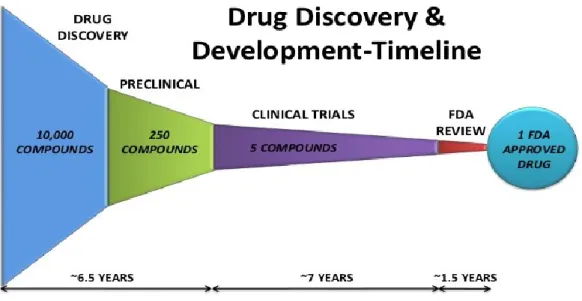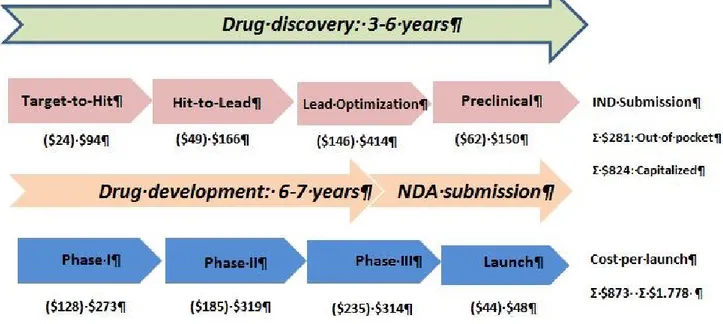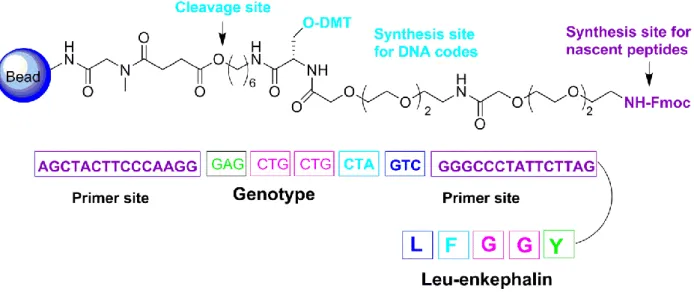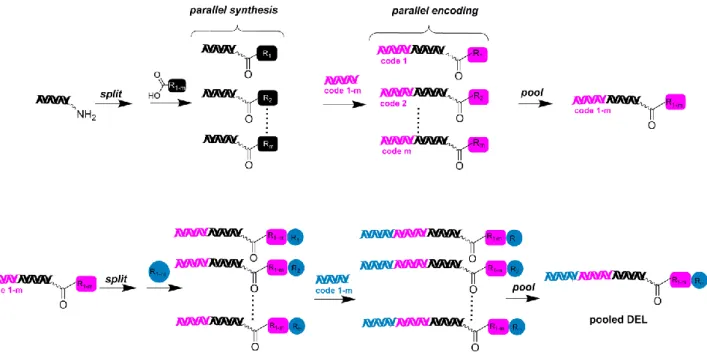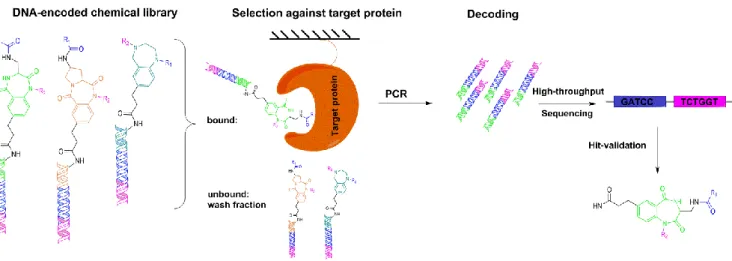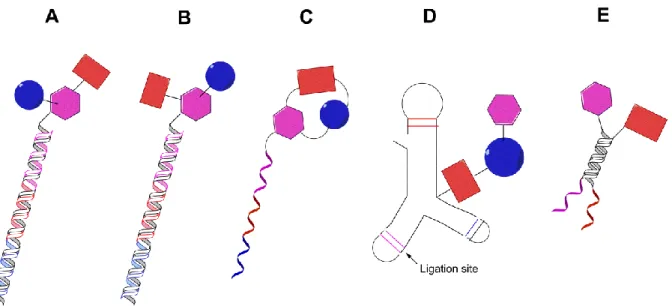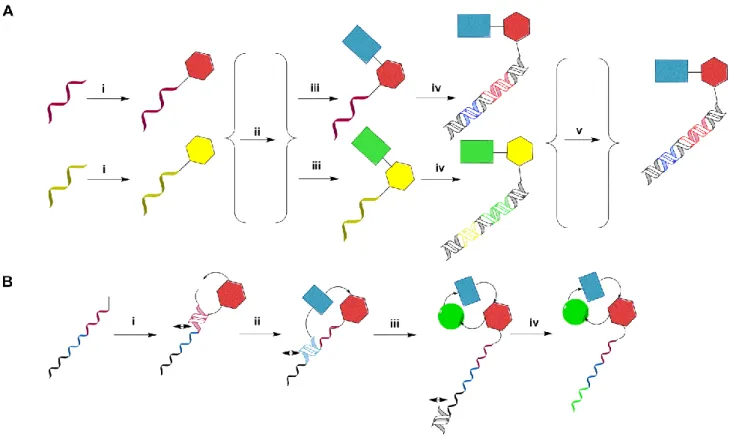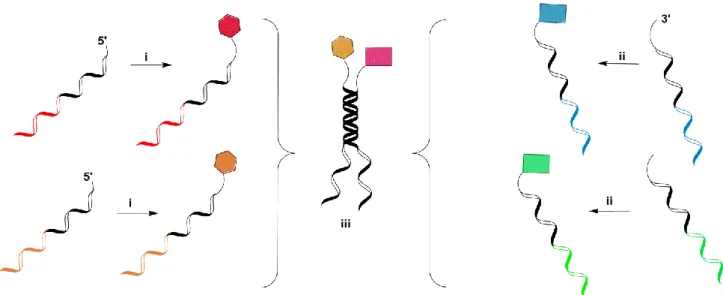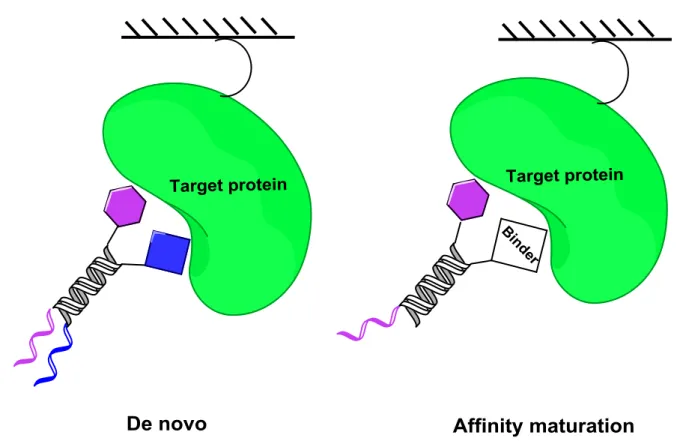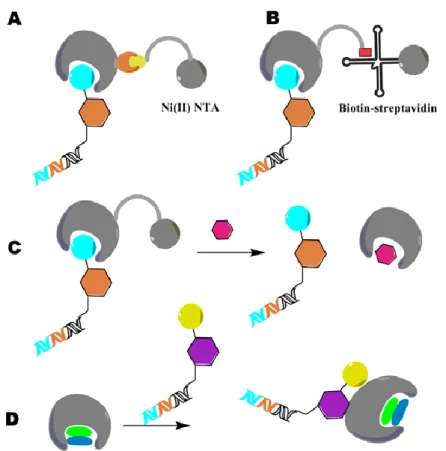DISSERTATION
For the requirement of the academic degree of the doctors in natural sciences
(Dr. rer. nat.)
Submitted to
The department of chemistry and chemical biology TU Dortmund University
By
M. Sc. Bugain Epse. Kamdem, Olivia From Cameroon
1. Advisor: Prof. Dr. Daniel Rauh
2. Advisor: Prof. Dr. Martin Engelhard
DISSERTATION
zur Erlangung des akademischen Grades Doktors der Naturwissenschaften
(Dr. rer. nat.)
Fakultät Chemie und Chemische Biologie der Technischen Universität Dortmund
vorgelegt von
M. Sc. Bugain Epse. Kamdem, Olivia
aus Kamerun
1. Gutachter: Prof. Dr. Daniel Rauh
2. Gutachter: Prof. Dr. Martin Engelhard
Eingereicht am 14.07.2017
Tag der mündliche Prüfung: 12.09.2017
Eidesstattliche Versicherung (Affidavit)
Bugain Epse. Kamdem, Olivia
______________________________
Name, Vorname (Surname, first name)
Belehrung:
Wer vorsätzlich gegen eine die Täuschung über Prü- fungsleistungen betreffende Regelung einer Hochschul- prüfungsordnung verstößt, handelt ordnungswidrig. Die Ordnungswidrigkeit kann mit einer Geldbuße von bis zu 50.000,00 € geahndet werden. Zuständige Verwaltungs- behörde für die Verfolgung und Ahndung von Ordnungs- widrigkeiten ist der Kanzler/die Kanzlerin der Techni- schen Universität Dortmund. Im Falle eines mehrfachen oder sonstigen schwerwiegenden Täuschungsversu- ches kann der Prüfling zudem exmatrikuliert werden, § 63 Abs. 5 Hochschulgesetz NRW.
Die Abgabe einer falschen Versicherung an Eides statt ist strafbar.
Wer vorsätzlich eine falsche Versicherung an Eides statt abgibt, kann mit einer Freiheitsstrafe bis zu drei Jahren oder mit Geldstrafe bestraft werden, § 156 StGB. Die fahrlässige Abgabe einer falschen Versicherung an Eides statt kann mit einer Freiheitsstrafe bis zu einem Jahr oder Geldstrafe bestraft werden, § 161 StGB.
Die oben stehende Belehrung habe ich zur Kenntnis genommen:
164139
_____________________________
Matrikel-Nr.
(Enrolment number)
Official notification:
Any person who intentionally breaches any regulation of university examination regulations relating to deception in examination performance is acting improperly. This offence can be punished with a fine of up to EUR 50,000.00. The competent administrative authority for the pursuit and prosecution of offences of this type is the chancellor of the TU Dortmund University. In the case of multiple or other serious attempts at deception, the candidate can also be unenrolled, Section 63, paragraph 5 of the Universities Act of North Rhine-Westphalia.
The submission of a false affidavit is punishable.
Any person who intentionally submits a false affidavit can be punished with a prison sentence of up to three years or a fine, Section 156 of the Criminal Code. The negligent submission of a false affidavit can be punished with a prison sentence of up to one year or a fine, Section 161 of the Criminal Code.
I have taken note of the above official notification.
14.07.2017
____________________ _________________________
Ort, Datum Unterschrift
(Place, date) (Signature)
Titel der Dissertation:
(Title of the thesis):
Synthesis of DNA-encoded screening libraries.
Ich versichere hiermit an Eides statt, dass ich die vorlie- gende Dissertation mit dem Titel selbstständig und ohne unzulässige fremde Hilfe angefertigt habe. Ich habe keine anderen als die angegebenen Quellen und Hilfs- mittel benutzt sowie wörtliche und sinngemäße Zitate kenntlich gemacht.
Die Arbeit hat in gegenwärtiger oder in einer anderen Fassung weder der TU Dortmund noch einer anderen Hochschule im Zusammenhang mit einer staatlichen oder akademischen Prüfung vorgelegen.
I hereby swear that I have completed the present dissertation independently and without inadmissible external support. I have not used any sources or tools other than those indicated and have identified literal and analogous quotations.
The thesis in its current version or another version has not been presented to the TU Dortmund University or another university in connection with a state or academic examination.*
*Please be aware that solely the German version of the affidavit ("Eidesstattliche Versicherung") for the PhD thesis is the official and legally binding version.
Synthese von DNA-kodierten Screening Substanzbibliotheken.
14.07.2017
“Commit everything you do to the Lord.
Trust him, and he will help you.”
Psalm 37.5
Dedication:
To the three pillars of my life: God almighty, my husband and my parents. Without you, my life will fall apart. I might not know where the life’s road will take me, but walking with You, God, through this journey has given me strength. You have given me so much, thanks for your faith in me, and for teaching me that I should never surrender.
ACKNOWLEDGEMENTS
Undertaking the PhD study at the technical university of Dortmund was a life-changing experience for me, and it would not have been accomplished without the help, support and collaboration of many people. I have here the great pleasure to thank them all.
First and foremost, I must express my sincere gratitude to my supervisor Dr. Andreas Brunschweiger for providing me the opportunity to undertake my PhD in his research group. I thank him for initiating the thesis project and giving me the possibility to use the excellent research facilities in his lab. His insightful discussions and enthusiastic determination are extremely valuable to me. I have immensely appreciated his guidance over the years of my PhD. I am extremely grateful for all his effort, advices, interpretations and for correcting all posters, presentations and drafts of papers. He helped me not only with priceless counsel in the field of DNA encoded chemistry; but he also broadened my horizon towards the application of chemistry to pharmaceutical. I thank him for recruiting me, being also always approachable and spent a huge amount of time reading and correcting this thesis.
I greatly acknowledge Prof. Dr. Daniel Rauh for offering me a warm welcome in the MedChem group. I sincerely thank him for his great support, as well as his guidance and encouragement through my PhD study. I thank him for the precious advices I received from him during my progress reports as well as all insightful suggestions and comments throughout my doctorate. This thesis would not have been possible without his coordination. His intelligent project guidance, his intervention and the many fruitful discussions were crucial for the completion of this thesis.
My sincere thanks go to Prof Dr. Martin Engelhard for taking over the second supervisor position.
More than a second supervisor, he helped me a lot by his constant support, by his presence and assistance during all my TAC meetings. I thank him for all the time he has invested to follow my project and for all the constructive conversations, we had together. I thank him for his esteem, for believing in me and for being on my side. To see him in the audience during my reports was a great relief, helping me to stay focused and concentrated. I am also grateful for his help with proof reading and revisions of this thesis. I thank him for his help and advices with the use of EndNote.
For his expertise and helpful advices. I thank him from the bottom of my heart. It was an outstanding experience having him as advisor.
For the collaboration on macrocycles synthesis I would like thank Prof. Dr. Tom Großmann together with his student Dr. Adrian Glas from the Chemical Genomic Center in Dortmund. I acknowledge them not only for the nice collaboration, but I thank Mrs Großmann for being my second IMPRS-supervisor and for actively participating to my TAC meeting. I thank Dr. Adrian Glas for providing me enough amount of the amino acids for my amide syntheses as well as the Grubbs catalyst for macrocyclization experiments. I thank him for explaining more than one time, for being so patient and pedagogic with all my questions.
Christa Hornemann: Since the beginning of my stay in Dortmund till the present day, I could always count on her goodwill and helpfulness. More than a contact person relating to IMPRS issues, you were a friend and mother for me during my PhD time. I thank you very much for believing in me.
Thank you for being so nice and lovely to me. Thank you very much Christa for advocating for me.
Thank you very much for pushing me to achieve my goals and for reassuring me when I felt they were out of reach. A big thanks to you for assisting me in the german version of the summary of this work and for being a source of love and energy ever since. Words cannot express how grateful I am to you.
I would like to express my special appreciation and thanks to Petra Alhorn and Martina Reibner for their help with administrative questions and ordering issues.
The members of the Brunschweiger group have contributed immensely to my personal and professional time at Dortmund. The group has been a source of friendships as well as good advice and collaboration. I am especially grateful to Mateja Klika, Kathrin Jung and Hazem Salamon. You have made the lab an enjoyable place to work and I very much appreciated your enthusiasm, help, friendship and collaboration. Thank you for an enjoyable atmosphere, inside and outside the workplace. A special acknowledgement goes to my office mate Mateja Klika. I thank her for her love, respect, trust, support and for our collaborative works. A firend like you is hard to find. One that touches you deep inside. You were a true friend. Thank you Mateja.
I thank my bachelor students Nadine Kaiser and Sven Brandherm for their respect and consideration. It was a great privilege for me to work with you and be in charge of you. I had a wonderful time getting to know you, and felt privileged to have met you.
Further I would like to acknowledge the financial support by IMPRS-CMB (the International Max- Planck-Research School in Chemical and Molecular Biology) that supported my work for my first year. I gratefully acknowledge the BMBF (Bundesministerium für Bildung und Forschung) for their financial support for the second and third years.
My time at Dortmund was made enjoyable in large part due to the many friends that became a part of my life: Esther, Bärbel, Gervais, Simone. I am grateful for time spent with them. My time at Dortmund was also enriched by the support of members of my church, who never stop to pray for me: Peter Lutz, Martha Speck, Adi Meier, Hannah Ermakov, Wolfgang Dirks and David Lückhof. I thank Dr. Raymond Mathis, Deborah Benett, Nick Bradshaw, Dr. Esther Nkuipou and Thorsten Doll for reading and correcting parts of this thesis. I thank them for their prayers and precious advices.
My thanks also go to all my dear friends, as well as the other people sharing my pain and happiness in the past, the present and the future: Conrad and Carole Bobale, Landry and Peclare Kamdem, Sinkoni and Rolande Tchana, Larissa, Vulon and Gaelle Meneckdem.
I would like to deeply thank my father, my mother, as well as my father and mother in law. Words cannot describe how important their care, affection, loves, prayers and tireless dedication have been essential for me to reach this stage of my life. Thank you, from the bottom of my heart “mon Papa chéri et ma Maman chérie”, for everything that you have done and still do for me. Your prayer for me was what sustained me thus far. I Love you so much. I give a very special thanks to all my brothers and sister: Gilles, Christian, Landry, Manuela and Kevin, for the essential support and encouragement you gave me all this time. You raised me with a love of science and supported me in all my pursuits.
Last but not least, I would like to express a more than a special thanks to my loving, supportive, encouraging, and patient husband Philippe Kamdem. The person with whom I share every moment and detail of my life. Thank you for always supporting me, for listening with attention and affection to all my thoughts, for our dreams and for every celebrated step we make together. Thank you Honey for your love, support and understanding in the time of Ph.D. hardship. Especially the writing period required sacrifices, which have been well appreciated.
I thank you for your faithful support during the last three years. You have always encouraged me.
Thank you for being there for me during the years I have needed for my thesis, and taking an interest in what I did. You are a wonderful husband. Without you, I would never be here. I love you.
TABLE OF CONTENTS
ACKNOWLEDGEMENTS 10
ABSTRACT 2
ZUSAMMENFASSUNG 6
Chapter I: INTRODUCTION 10
I-1. Background of drug discovery 11
I-2. Drug discovery today 13
I-3. The identification of small organic molecules in drug discovery 14
I-3.1. Technologies for identification of bioactive compounds 15 I-3.2. First practical applications of DNA-encoded combinatorial chemistry 17
I-3.3. Progress in DNA-encoded chemical libraries 22
I-4. Selection strategies 28
I-5. DNA sequencing for library decoding 30
I-6. Bioactive compounds from DNA-encoded small molecule libraries 31
I-7. DNA-routed libraries 35
I-8. DNA-templated libraries 36
I-9. Self-assembled libraries 37
I-10. Privileged scaffolds in medicinal chemistry 46
I-11. Limitations of DNA-encoded libraries 49
I-12. Aims and objectives 49
Chapter II: Synthesis of a DNA-encoded library based on a
benzodiazepine scaffold. 58
II-1. Benzodiazepines as bioactive compounds and drugs 59
II-2. Synthesis of trifunctionalized benzodiazepines for library synthesis 60 II-2.1. Synthesis of trifunctionalized 1,4-benzodiazepine-2,5-dione scaffold (1) 61 II-2.2. Synthesis of trifunctionalized 1,4-benzodiazepine-2,5-dione scaffold (2) 63 II-2.3. Synthesis of trifunctionalized tetrahydro-benzodiazepine (3) 67
II-2.4. Optimization of the amide synthesis for the coupling of scaffolds to 5’-
aminolinker modified DNA 72
II-2.5. Synthesis of a DNA-encoded library based on tetrahydrobenzodiazepine (3) 75
Chapter III: Development of a modular solid phase synthesis strategy for DNA‐macrocycle conjugates 80
III-1. Introduction 81
III-2. Macrocyclic peptides 84
III-3. Macrocyclization of peptides by ruthenium catalyzed ring-closing metathesis 85
Chapter IV: Development of an acid catalysed approach to an oligo- thymidine initiated DNA-encoded ß-carboline library 90
IV-1. Introduction 91
IV-2. ß-carboline 92
IV-3. The Pictet-Spengler reaction 93
IV-4. Oligo-thymidine initiated DNA-encoded ß-carbolines library 99 IV-4.1. Synthesis of the hexT-5’-PEG-aminolinker conjugate 100
IV-4.2. Synthesis of hexT-tryptophane conjugates 101
IV-4.3. Synthesis of hexT-β-carbolines from hexT-tryptophane conjugates by Pictet-
Spengler condensation 102
IV-4.4. Investigation of different catalysts 103
IV-4.5. Investigation of different solvents [a] 105
IV-4.6. Investigation of different concentrations and reaction times for the synthesis of
hexT-β-carboline conjugates 106
IV-4.7. Control experiments with Fmoc protected alanine 108
IV-4.8. Control experiments: Pictet-Spengler reaction with tryptophane conjugates of
hexa-A, hexa-G, hexa-C, and a mixed sequence 109
IV-4.9. Introduction of a second set of building blocks 111
IV-4.10. Projected synthesis of a tiDEL library based on ß-carbolines 115
IV-4.11. Synthesis of a reference compound 116
Chapter V: SUMMARY AND OUTLOOK 118
Chapter VI: EXPERIMENTAL PART 124
VI-1. Materials and instruments 125
VI-2. Synthesis of DEL9588 DNA-encoded library based on one scaffold 128
VI-2.1. Preparation of benzodiazepine scaffolds for library synthesis 128 VI-2.2. Synthesis of the functionalized benzo-1,4-diazepine-2,5-dione 2 136
VI-2.3. Synthesis of the tetrahydrobenzodiazepine 3 145
VI-3. Coupling of carboxylic acid building blocks to DNA scaffold conjugates 152
VI-3.1. Synthesis of DNA-PEG-linker conjugate 94a 152
VI-3.2. Synthesis of DNA-scaffold conjugate 95 153
VI-3.3. Coupling reactions of 114 carboxylic acids to DNA-scaffold conjugate 96 154 VI-4. Coupling of carboxylic acid building blocks to DNA scaffold conjugates 163
VI-5. Evaluation of halides for library synthesis 164
VI-6. Macrocyclization of peptides by ruthenium-catalyzed ring-closing metathesis 174
VI-6.1. 1st amide coupling: Fmoc-NH-PEG(4)-COOH 175
VI-6.2. 2nd amide coupling: Fmoc-X5-OH 175
VI-6.3. 3rd amide coupling: Fmoc-Leu-OH 176
VI-6.4. 4th amide coupling: Fmoc-Ala-OH 176
VI-6.5. 5th amide coupling: Fmoc-XR-OH 177
VI-6.6. Ring-closing metathesis on CPG by ruthenium catalysis 177 VI-7. Development of an acid catalyzed approach to an oligo-thymidine initiated DNA-encoded ß-
carbolines library 178
VI-7.1. Synthesis of the 5’-amino-PEG(4)-hexathymidine conjugate “hexT” 178
VI-7.2. Synthesis of hexT conjugate 141 179
VI-8. Synthesis of hexT-β-carboline conjugates 142A – 142DJ by Pictet-Spengler reaction, and
building block validation for tiDEL synthesis 180
VI-8.1. Optimization of the reaction conditions for the synthesis of hexT-β-carboline
conjugates 180
VI-8.2. Synthesis of hexT-β-carboline conjugates 142A – 142DJ 181
VI-9. Synthesis of reference molecules and educts 191
APPENDIX 194
LIST OF ABBREVIATIONS 212
LIST OF TABLES 216
LIST OF CHROMATOGRAMS 218
REFERENCES 220
ABSTRACT
The discovery of small organic molecules capable of binding to specific biological targets represents a decisive step towards the development of novel therapies for the treatment of human diseases.
However, identifying such small bioactive molecules is often a complex process involving numerous challenges, including low-affinity binding to target proteins. This necessitates the development of effective and powerful strategies to generate large sets of chemical compound libraries and novel screening methodologies to identify binding molecules. High throughput screening (HTS) has proven to be a powerful tool in facilitating the screening of large compound collections against disease-related protein targets. However, HTS has many requirements that must be fulfilled, including: miniaturized and compatible assay formats, an infrastructure with a high degree of automatization, large-scale data analysis, and trained staff.Owing to these significant technical and financial requirements, new technologies to facilitate ligand discovery that can be implemented in the academic sphere are highly desirable. In this regard, technologies based on DNA encoded chemical libraries (DELs) offer a considerable advantage over conventional HTS technologies as they are rapid, cost-effective, and employ user-friendly screening logistics.Two points in particular make the screening of DNA-encoded libraries attractive. Firstly, large numbers of compounds can be pooled and screened, so that a dedicated infrastructure for handling of compound libraries is unnecessary. Moreover, only one assay format is required for all protein targets facilitating assay development. Hits emerging from the selection assay must be validated in additional assays and may serve as lead compounds for further development towards probes or even therapeutic agents.
In the first section of this thesis, the general synthesis of three different functionalized benzodiazepines (compound 1, 2, 3) known as “privileged scaffolds” is established. Privileged scaffolds are interesting structures that are overrepresented among bioactive small molecules and therefore constitute an attractive framework for probe and drug discovery. With this in mind, the DEL methodology was applied to construct a DNA-encoded library based on one of these benzodiazepines (compound 3). This yielded a DNA-encoded chemical library of 9588 members (DEL9588) relying on introduction of building blocks by amide bond forming reaction and Cu (I)- catalyzed azide-alkyne cycloaddition. Although the DEL-approach increases chances to find specific binders to relevant proteins, it remains limited due to the incompatibility of DNA with many chemical transformations.
scaffold 1 scaffold 2 scaffold 3
1 2 3
The third and final section of the thesis proposes a strategy to overcome this limitation by establishing new protocols of DNA-compatible chemistries that are robust, working in the presence of strong catalysts without degradation of the DNA. For this purpose, the “ oligoThymidine initiated DNA-Encoded Chemistry” (TiDEC) strategy for DEL synthesis has been developed and applied for the successful Pictet-Spengler cyclization of tryptophan and aldehydes to form drug-like heterocyclic structures (ß-Carbolines) at ambient temperature under acidic conditions using a hexT DNA. This resulted in the formation of 114 ß-carbolines conjugates that were subsequently encoded by DNA ligation. Besides, methodologies for the construction of a DNA-encoded chemical library based on those ß-carbolines were investigated, featuring the stepwise addition of two independent sets of chemical moieties onto the initial ß-carboline scaffold.
Amide synthesis represents an important reaction for the generation of DNA-encoded combinatorial libraries. The investigation process leading to suitable reaction conditions for amide conjugation on solid phase on DNA was a lengthy optimization effort. Fortunately, it revealed the Fmoc chemistry to be compatible with the DNA on solid support, preserving the DNA integrity.
Encouraged by this observation, a modular solid phase synthesis strategy for DNA‐macrocycle conjugates was developed. The second section of this thesis presents the successful macrocyclization of a peptide composed of four amino acids by ruthenium-catalyzed ring-closing metathesis (RCM) on DNA on solid phase making use of the first generation Grubbs catalyst 39. This experiment has proved on one hand, synthesis on solid-phase to be particularly attractive, as it allows to drive chemical reactions to completion and to expand the scope of DNA-compatible chemical reactions to water-free conditions.
On the other hand, the macrocyclization of peptides by RCM is tolerated by a hexT adapter oligonucleotide designed for this purpose, opening the door to the synthesis of a DNA-encoded chemical library based on macrocycles that can be screened against targets involved in protein- protein interactions. Overall, the experiments performed show that an adapter oligonucleotide consisting of thymine nucleobases can enable the use of various catalysts utilized by medicinal chemists to initiate DNA-encoded library synthesis based on heterocycles, as well as on macrocycles.
ZUSAMMENFASSUNG
Die Identifizierung und Isolierung neuer bioaktiver Verbindungen, die mit medizinisch relevanten Proteinen in Wechselwirkung treten können, ist eine Herausforderung nicht nur in der pharmazeutischen Industrie, sondern auch in der akademischen Forschung. Das Verfahren, kleine bioaktive Moleküle zu identifizieren, ist oft komplex. Neue Wirkstoffe werden oft in Screening- Verfahren mit dem Hochdurchsatz-Screening (HTS) identifiziert. Diese gut etablierte Strategie ist allerdings sehr zeitaufwändig und kostspielig. Aus diesem Grund besteht ein zunehmender Bedarf für die Entwicklung neuer Methoden, die in der Forschung, insbesondere der universitären, umgesetzt werden können, um die Entdeckung neuer Liganden zu erleichtern und zu beschleunigen. In diesem Zusammenhang erweisen sich besonders DNA-kodierte chemische Substanzbibliotheken (DELs, engl. DNA Encoded Libraries) als eine vielversprechende Methode, um sehr große Substanzbibliotheken simultan auf Bindungsaffinitäten gegen ein Zielprotein der Wahl zu testen. DNA-kodierte chemische Bibliotheken bestehen aus einer Vielzahl verschiedener organischer Verbindungen, die individuell an spezifische DNA-Sequenzen gekoppelt sind. Dies ermöglicht eine Bibliothek als Substanzgemisch in Selektionsexperimenten mit einem immobilisierten Protein in Kontakt zu bringen und Proteinbinder durch Sequenzierung ihres spezifischen DNA-Codes zu identifizieren. Das Verfahren ist auch deshalb attraktiv, da nur ein Assayformat benötigt wird.
Im ersten Teil der vorliegenden Dissertation wird die Synthese von drei mit Carbonsäure, geschützem Amin und terminalem Alkin funktionalisierten Benzodiazepinen dargestellt (Verbindung 1, 2, 3). Benzodiazepine werden in der medizinischen Chemie auch als "privilegierte Gerüste"
bezeichnet.
Scaffold 1 Scaffold 2 Scaffold 3
1 2 3
Privilegierte Gerüste sind unter kleinen bioaktiven Molekülen überrepräsentiert und gelten daher als attraktive Verbindungen in der Wirkstoffforschung gehören. Daher wurde eine DNA-kodierte Bibliothek basierend auf einem dieser Benzodiazepine (Verbindung 3) dargestellt. Dies ergab eine DNA-kodierte chemische Bibliothek von 9588 Molekülen (DEL9588) beruhend auf Amidsynthese und Click-Chemie für die Einführung vonSubstituenten.
Obwohl die Synthese von DELs ein validiertes Verfahren darstellt, die von einer Vielzahl von akademischen und industriellen Arbeitsgruppen als Quelle für bioaktive Moleküle genutzt wird, können viel Synthesemethoden aufgrund der Inkompatibilität mit DNA nicht eingesetzt werden. Die DNA besteht aus vier Nukleobasen: die Purine Adenin (A) und Guanin (G) sowie die Pyrimidine Thymin (T) und Cytosin (C). Verschiedene Reaktionsbedingungen können die DNA-Integrität beinflussen. Starke Oxidationsmittel können zum Beispiel den Imidazolring von Guanin oxidieren.
Saure pH-Werte führen zur Depurinierung. Entsprechend katalysierte Reaktionen, werden in der Literatur als inkompatibel mit DNA-Chemie beschrieben. Die sogennante oligoThymidine DNA- kodierte Chemie (TiDEC)-Strategie, basiert auf der Feststellung, dass die Inkompatibilität von vielen Katalysatorsystemen mit DNA auf der Reaktivität der Purinbasen beruht. Daher werden zur Initiierung des Aufbaus unserer DELs kurze DNA-Stränge, die nur aus Pyrimidinbasen bestehen, die wir Initiator-DNAs nennen, verwendet. Durch die Verwendung kurzer 5'-Amino-C6-Hexathymidin- Einzelstränge (hexT) ist es möglich, bekannte Arzneistoffe und Derivate in Form einer DEL zu synthetisieren.
Fmoc-Peptidchemie ist kompatibel mit an Festphase gebundenem hexT. Daher wurde eine modulare Festphasensynthese-Strategie für die Synthese eines DNA-Makrozyklus-Konjugats an der DNA entwickelt. Der zweite Teil dieser Arbeit stellt die erfolgreiche Makrozyklisierung eines Peptids dar, das aus vier Aminosäuren synthetisiert wurde, und durch Ruthenium-katalysierte Ringschlussmetathese (RCM) zyklisiert wurde. Dabei wurde der Grubbs (I) Katalysator 39 verwendet. Dieses Experiment hat gezeigt, dass die Makrozyklisierung von Peptiden durch RCM auf einem für diesen Zweck konzipierten hexT-Adapter-Oligonukleotid toleriert wird. Dieses Ergebnis kann die Tür zur Synthese einer DNA-kodierten chemischen Bibliothek basierend auf Makrozyklen öffnen, die zum Beispiel gegen Ziele getestet werden können, die in Protein-Protein- Wechselwirkungen involviert sind.
Der dritte Teil dieser Arbeit schlägt eine weitere Strategie vo, um die Stabilität des hexT auszunutzenr: Die TiDEC-Strategie wurde für die erfolgreiche Pictet-Spengler-Zyklisierung von Tryptamin mit verschiedenen Aldehyden unter Wasserabspaltung zur Herstellung von ß-Carbolinen verwendet. Die Reaktionen wurden unter Säure-katalyse durchgeführt. Dies führte zur Bildung von 114 ß-Carboline-Konjugaten, die anschließend durch DNA-Ligation kodiert wurden.
Letztendlich zeigen diese Experimente, inwiefern ein Adapter-Oligonukleotid bestehend aus Thymin-Nukleobasen die Verwendung von verschiedenen Katalysatoren erlaubt, die in der organischen Chemie häufig verwendet werden. Diese Erkenntnis ermöglicht auf der einen Seite die Synthese von DNA-kodierten Bibliotheken basierend auf Heterozyklen sowie Makrozyklen. Auf der anderen Seite erweitert sie den Katalog von DNA-kompatiblen chemischen Reaktionen, die der Konstruktion von großen, vielfältigen Molekülbibliotheken dienen.
Chapter I: INTRODUCTION
The identification of bioactive small molecules capable of binding to a target protein is one focus of modern drug discovery.1-2 Technologies like sequencing of the human genome and advances in proteomic as well as transcriptomic analysis have furthered understanding of living systems and have enabled the identificationof various new biological targets associated with many human diseases.3 However, the synthesis of small molecules capable of addressing such target proteins still remains a challenge. Conventional high-throughput screening (HTS) campaigns are a standard technology in drug developmentbut closed to academic research as they require dedicated infrastructure.4-5 There is consequently an urgent need in the field of medicinal chemistry to develop more efficient drug discovery techniques that accelerate drug identification. DNA-encoded combinatorial chemistry shows great promise as drug discovery technology. It addresses the limitations of the conventional high-throughput methodology for hit discovery.6 The concept of antibody phage display technology, which involves linking antibody binding properties (“phenotype”) with the genetic information coding for the antibody (“genotype”), has been translated to DNA-encoded chemical libraries based on the collections of organic molecules covalently linked to a unique DNA tag serving as an amplifiable identification bar code.7 DNA- encoding accelerates the drug discovery process, since it allows the rapid and inexpensive in vitro selection of ligands by affinity capture at sub-picomolar concentrations of any target protein of interest. The fact that this technology does not require screening infrastructure is also a great advantage.8
I-1. Background of drug discovery
Drug discovery and development has a long history. It is the process by which new drugs candidates are synthesized and spans the fields of medicine, biotechnology, pharmacology and medicinal chemistry.9 In the past, new candidate medications were often discovered by chance.10 They were isolated by identifying the active ingredient from traditional remedies or a combination of trial and error experimentation, followed by observation of human and animal reactions to ingestion of the drug candidates.11 Later, collections of small chemical compounds, natural products or extracts were used in screening assays with cells or organisms in order to identify substances or moieties possessing a desirable therapeutic effect.
Over time, drug discovery developed still further, becoming a capital-intensive process that necessitates large investments by the pharmaceutical industry, as well as national governments providing grants and loan guarantees. However, despite remarkable advances in technology and an improved understanding of biological systems, drug discovery remains a cumbersome, lengthy, and extremely costly process with a low rate of new therapeutic discovery (Figure I-1). In fact, the process takes approximately 15 years to complete, and the current costs of developing a new drug are estimated to be around a billion dollars.12 The identification of biologically active compounds to provide an insight into patho-physiological processes and novel drugs against diseases is both an aim in academia and an important priority in many pharma companies.2 However, in the last decade, there have been an increasing number of discussions about a looming crisis in pharma companies due to the so-called patent cliff.13 To date, there are still many diseases for which medications are currently not available. These include neurodegenerative diseases such as Alzheimer’s or Parkinson’s disease, various malignant diseases and the resurgence of infectious diseases due to the development of resistance to available therapeutics. On the other hand, decoding of the human genome has revealed several proteins that are involved in pathophysiological processes and are therefore of great interest for pharmacology.14 However, several promising targets, such as protein-protein interactions in the ubiquitin-proteasome system and epigenetic proteins are challenging to drug discovery.14
Figure I-1: Overview of drug discovery research and development timeline of the screening of a 10,000 compounds library. The process leading to a drug or therapy is lengthy and costly. The figure was taken from rahul_pharma/drug-discovery-and-development homepage.15
I-2. Drug discovery today
The identification of bioactive small molecules against medically relevant proteins constitutes a challenge in drug discovery (Figure I-2).1 The screening of large compound collections containing up to 106 different molecules using automated HTS has proven to be very effective in the discovery of new bioactive compounds, and therefore appears to represent a good basis in industry for hit-to- lead development.4 However, traditional hit development programs by HTS are very demanding in terms of time, suitable logistics and finance.1, 5, 11 Accordingly, new innovative, cost-effective and broadly applicable concepts to screen small molecule libraries are urgently needed in academia.7
Figure I-2: The discovery of new ligand methodologies may aid in considerably reducing the cost of the early drug discovery process. It is important to note that the risks of costly late-stage failures in preclinical or clinical trials can be decreased by good-quality drug candidates. IND: Investigational New Drug. NDA: New Drug Application Capitalized costs include interest expenses until drug launch for financing activities.16 The costs during drug development and discovery process was adapted from Paul et al., 2010.16
In the last decade, there has been slow progress regarding the number of novel drugs approved by the US Food and Drug Administration (FDA): also called new molecular entities (NMEs).17-18 This is the case despite the fact that worldwide R&D investments rose stronglyduring the same period.17-18 This outcome can be explained by the fact that the R&D efficiency (R&D costs as a percentage of net sales) of pharmaceutical industries declined constantly until the 2000s.
This decline in R&D performance is mainly attributed to the tortuous road (up to 15 years) and the associated costs leading to the identification of novel compounds following FDA stringent drug approval processes. Given the current challenges, it is therefore of pivotal importance to find alternative measures to improve R&D efficiency and subsequently strengthen the pharmaceutical industry sector.14, 17-18
The scientific progress in medicinal chemistry leading to the development of new and approved biological entities plays a significant role in the acceleration of further drug discoveries in the pharmaceutical industry.11, 17, 19 The example of antibody phage display emphasizes this point, as it was made possible using a selection-based strategy to generate monoclonal antibodies against any target protein of choice within a short period of time.20-24 In this context, large collections of phages exhibiting single-chain variable fragments (scFv) as fusion complexes on their surface could be simultaneously screened against a target protein of interest in affinity selection experiments. This led to the identification of several compounds, such as adalimumab (Humira®); a fully human monoclonal antibody against TNF-α that has further contributed to the management of breast cancer. The cost of this project reached the $3 billion annual sales mark in the year 2007.25-26 The technology also possesses several analogies to DNA-encoded combinatorial chemistry, which is useful for the rapid generation and interrogation of massive collections of chemical compounds to tackle new target classes. DNA-encoding of small molecules therefore allows selection-based interrogation of small-molecule libraries against a target protein of interest.
I-3. The identification of small organic molecules in drug discovery
An important challenge in medicinal chemistry remains the development or identification of small molecules capable of specifically binding to proteins with pharmaceutical properties. Sequencing the human genome as well as the genomes of multiple pathogens, yielded hundreds to thousands of potentially novel biological targets. Functional genomic approaches were introduced into the drug discovery area, comprising RNA profiling, proteomics, antisense and RNA interference, model organisms and high-throughput, genome-wide over-expression or knockdowns in the identification of new drug targets.27
Thanks to an improved understanding of the mechanisms of many diseases at a molecular level, scientists are now able to associate different proteins with the pathogenesis of diseases. However, it is challenging to use this rich source of information in a manner that can assist in the development of novel, more effective and safer drugs. Moreover, new ligands need to be isolated in order to analyze molecular pathways and study protein function.1 Technologies that enable new ligand development are sorely needed, as they contribute to a better understanding of complex biological processes and speed up drug discovery. Straightforward development and isolation of specific binders to target proteins can be achieved with the selection of large polypeptide collections (e.g. antibody libraries).21-22, 24 However, these reagents are not able to interfere with intracellular biochemical processes.24
I-3.1. Technologies for identification of bioactive compounds
From a historical point of view, drug discovery has been divided into three periods; (i) before, (ii) during and (iii) after the twentieth century.10 Almost all drugs discovered before the twentieth century were found by chance.11 However, as a result of notable advances in the different disciplines involved, drug discovery quickly became a more rational process. Among the noteworthy techniques made available to bring this process forward by the end of the twentieth century was the development of molecular structures of drugs using different methodologies such as molecular modeling, combinatorial chemistry, high-throughput screening and advanced molecular biology methods.10-11
I-3.1.1. High-throughput screening
Traditional technologies used in the identification of small molecule ligands against a target protein of choice use a collection of chemical compounds or compound libraries, which are screened one molecule at a time. The principle of the assay here is based on enzymatic activity of the target protein. The high-throughput screening (HTS) approach enables the screening of between 10,000 to 1,000,000 compounds. This greatly improves the chances of discovering novel and efficient drugs.
However, the screening is cumbersome and expensive in terms of library synthesis, logistics, screening and management.28
Moreover, the HTS of compound libraries does not always yield hits. In summary, although the advantages of the technology are apparent, its use in the academic environment is restricted due to its high costs. A frequently used strategy to circumvent this problem is the use of structural information in “virtual screening” with the aim of reducing the number of compounds that need to be evaluated.28-30
I-3.1.2. Fragment-based approach
Another routinely used alternative for the identification of ligands with convenient binding affinity and pharmacological features is the fragment-based approach.29, 31-32 Fragment-based approaches analyze small molecules with molecular masses of < 300 Da using NMR or X-ray crystallography, and have proved to be an efficient and complementary method for early stage drug development in recent years.29 Indeed, this approach differs from HTS in almost every respect: library size, screening method, as well as the dependence on structural methods.32 Fragment-based drug discovery relies on the close interaction of structural biology and synthetic chemistry. Taking a structural and molecular view of biological targets, combined with a stepwise and logical medicinal chemistry strategy, this technology represents an attractive tool not only to chemical biologists, but also to synthetic and computational chemists.31
I-3.1.3. Display technologies
Among the various biological libraries that have been developed, most attention has been directed at those which enable the identification of bioactive proteins or peptides, especially as proteins are natural modulators of phenotype and therefore represent obvious drug candidates. Display technologies as combinatorial biology techniques are likely to play an increasingly more important role in the future of drug discovery and include phage display technology and ribosome display technology. Phage display technology, involving the isolation of binding polypeptides from large libraries, has also demonstrated its value in the development of new bioactive molecules (Figure I- 3).33 Millions to billions of polypeptides displayed on the surface of a filamentous phage make use of the physical linkage between their potential binding properties (“Phenotype”) and the corresponding genetic information enclosed in the phage (“Genotype”).
Libraries can be panned against target antigens that are immobilized on a solid support. Through several washings steps, non-binding molecules will be eliminated whereas the remaining binding molecules will be captured.34-35
Figure I-3: The display technology exploits the properties of a replication initiator protein from the E. coli bacteriophage P2. The protein is the product of the viral A-gene (P2A) and is an endonuclease that initiates a rolling circle replication process by binding to the viral origin (ori) and introducing a single strand discontinuity (nick) in the DNA. Affinity selection consists of the incubation of pools of covalent DNA–protein complexes with an immobilized target molecule. Binding moieties are retained on the solid surface while non-specific complexes are removed by washing steps. The physical link between the gene and the gene product results in the coincident retention of both target-specific polypeptide and its encoding DNA. The retained DNA is then amplified by PCR for further rounds of selection or used to generate a clonal archive of the binding domain’s gene. The figure was taken from Mattheakis et al., 1994.35
I-3.2. First practical applications of DNA-encoded combinatorial chemistry
The emergence of combinatorial chemistry, particularly the “split-and-pool concept” has opened the door to the synthesis of compound collections with unprecedented size (Figure I-5). This concept operates as follows: (i) First a set of chemical compounds comprising a members is pooled in equimolar amounts and split into b aliquots. (ii) Then, a specific reactant of a second set of chemical compounds containing b members is added to each aliquot yielding a reaction products.
(iii) Finally, aliquots are pooled again resulting in a collection of a x b different reaction products.
This synthetic route can be repeated several times, generating polymeric compounds such as polypeptides (Figure I-4). Despite the great advantages offered by the split-and-pool methodology, the identification of bioactive small molecules from these compound collections remains problematic since individual members fail to retain their spatial information during split-and-pool synthesis. Brenner and Lerner were the first to suggest the usage of DNA as a tag to provide the information that would be lost during split-and-pool synthesis.36 In their theoretical article published in 1992, Brenner and Lenner described how to adapt the concept of linking phenotype and genotype to organic chemistry. In comparison to polypeptide display technologies, they proposed the synthesis of amino acid sequences (“phenotype”) and encoded oligonucleotides on the same bead (Figure I-4). In this approach, synthetic chemical moieties and encoded DNA are physically connected and the encoded chemical libraries can be screened in the same manner as the affinity selections utilized in phage display technology. PCR priming sites are attached to the appropriate DNA sequences, which in turn play the role of bar codes. This facilitates the decoding of chemical structures by PCR amplification and DNA sequencing. To demonstrate that the library construction strategy does not depend on biological systems, an enlarged catalog of chemical building blocks can be used. The practical application of DNA-encoding strategies necessitates the compatibility of unprotected DNA with the covalent synthesis of the chemical moiety. Brenner and coworkers thus demonstrated the possibilty of synthesising DNA-encoded chemical libraries based on peptides, which is helpful for further investigation in this area. During the 1990s, diverse alternative encoding strategies were developed with the aim of expanding the field of compound synthesis methodologies beyond DEL-compatible chemistry. However, the selective amplification of DNA by PCR was found to be an indispensable step for hit detection and statistical analysis of DELs.
Moreover, DNA molecules display additional benefits for encoded chemical libraries, including (i) commercially available oligonucleotides that can be designed by each scientist; (ii) the straightforwardness and efficiency of DNA purification methods, such as ethanol precipitation: (iii) the accessibility of DNA-processing enzymes, and (iv) the availability of high-throughput DNA sequencing technologies (e.g., Roche 454, Illumina Solexa)37 that permit the extraction of DNA sequence information in a parallel fashion. However, the identification of DNA-compatible reaction conditions remains crucial to access new chemistry for library construction.
The first implementation of DNA-encoded combinatorial chemistry was performed in 1993 by Brenner and Janda in an experiment where five alternating synthesis cycles of amide-bond were performed to form reactions and nucleoside phosphoramidite chemistry. This demonstrated the potential to orthogonally synthesize pentapeptides and their corresponding oligonucleotide tags on the same bead (Figure I-4).38
Figure I-4: A chemical scaffold with orthogonal protecting groups (O-DMT and N-Fmoc) allows the bidirectional synthesis of oligonucleotide and peptide sequences. A cleavage site allows the release of the DNA-encoded peptides from the solid support. An example of oligonucleotide-peptide conjugate after bead- release is depicted at the bottom. This picture was adapted from Leimbacher et al., 2012.38
The selection of DNA-encoded Leu-enkephalin pentapeptide (LFGGY) in this manner, as the result of synthesis against the antibody 3-E7, displayed strong binding when compared with the reference peptide (Kd = 24 nM), whereas the bivalent Leu-enkephalin displayed a Kd = 7 nM.39 Hence, not only were they able to use DNA-encoded combinatorial chemistry, but they were also able to show that a greater binding at the target protein was achieved. Brenner and coworkers also showed that bulky DNA tags did not interact with target binding and corresponding DNA codes were amplifiable by PCR.39 This finding demonstrated the efficiency of this technology in terms of the screening of libraries against target proteins. Another independent group, Gallop and co-workers, experimented on the orthogonal synthesis of a library containing 823,543 (77) heptapeptides. These were bound to corresponding DNA tags, on the same bead.39 Coding sequences were enclosed by PCR priming sites for DNA amplification.
An affinity selection was then performed and beads bearing the amino acid sequence RQFKVVT were isolated based on their aptitude to bind the fluorescent monoclonal antibody D32.39, known to bind the reference peptide RQFKVVT with a Kd = 0.5 nM.39 FACS-based isolation and PCR amplification revealed the sequence of the related DNA code. In 2004, Harbury and co-workers showed that the field of chemical reactions can be extended to completely water-free conditions using diethylaminoethyl (DEAE) resin for the immobilization of DNA during the synthesis of displayed chemical moieties.40
Figure I-5: Schematic representation of a DNA-encoded library containing two building blocks constructed in a split-&-pool fashion. The initial building block is conjugated to the oligonucleotide by amide synthesis and encoded with a further set of oligonucleotide by DNA ligation. Afterwards the oligonucleotide conjugate compounds are mixed, splitted into different reaction vessels and reacted again with an additional building block. Following encoding, these steps are repeated a given number of times and the final library is pooled together.
As written above, the principle of linking “Genotype” and “Phenotype” for selection assays can be transposed into the area of small organic molecules by encoding them with unique DNA fragments that are used as amplifiable identification bar codes (Figure I-6).36 This concept would be useful for the identification of small organic molecules capable of binding to target proteins with high affinity and specificity, based on the association of individual chemical compounds to unique DNA- fragments serving as identification bar-codes.
Figure I-6: A typical selection process with DNA-encoded chemical libraries comprises the following steps: (i) incubation of the library with a target protein of interest immobilized on a solid support, (ii) removal of non- binders by washing steps of the solid support, (iii) PCR amplification of the DNA codes corresponding to the binders, (iv) assessment of the relative quantification of library codes after selection using high-throughput sequencing, and (v) re-synthesis of identified compounds in the absence of a DNA-tag for biological or biochemical assays.
Like polypeptide-based display technologies, DNA-encoded small molecules can be panned against a target protein of choice. Non-binders are then removed by washing cycles and sequences of binders can subsequently be enriched and then amplified by PCR (Figure I-6).36 The concept of DNA- encoded chemical libraries was firstly described in 1992 by Brenner and Lerner, proposing the alternated synthesis of peptides and oligonucleotides on the same solid support (Figure I-7C).36 The authors planned to use this concept for the synthesis of peptides and oligonucleotides on the same bead. However, their concept could not be put into practice for library construction, presumably due to limitations in library size (number of beads is limiting) and the requirement for an orthogonal synthesis of peptides and oligonucleotides on the same solid support.36 Since that time, a number of different approaches have been developed. In addition to the direct linkage of small molecules to an encoding DNA tag (Figure I-7E), PNA-encoded libraries have been introduced and are now used by many groups (Figure I-7D).41-42 The use of different DEL construction methodologies has extended the discovery of novel ligands and inhibitors against a variety of biomedically important targets.43
I-3.3. Progress in DNA-encoded chemical libraries
The DNA encoding technology has become a formidable strategy for the synthesis of large combinatorial libraries, since the DNA tag itself allows library construction in different ways (Figure I-7).41, 44-48 The simplest way to obtain a DNA-encoded chemical library involves the attachment of an individual organic entity to a unique DNA strand. Itis obtained when a single organic compound is coupled to each DNA strand (Figure I-7A-D).41, 44-48 In contrast, the so-called “dual pharmacophore libraries” are characterized by the presence of pairs of chemical moieties at the two extremities of complementary DNA fragments (Figure I-7E).49 A classification is then achieved based on library synthesis categorizing single pharmacophore libraries which includes: i) libraries in which building blocks are brought together by a split-and-pool strategy in a combinatorial fashion as well as encoding DNA strands (Figure I-7A, B).41, 44-45; and ii) libraries for which DNA-templated synthesis is applied in the construction step (Figure I-7C, D).46, 48, 50
Figure I-7: “Single pharmacophore DNA-encoded chemical libraries” display a single chemical compound on one DNA-strand, in comparison to “dual pharmacophore DNA-encoded chemical libraries”. E illustrates pairs of chemical structures at the two extremities of complementary DNA strands. For the construction of single pharmacophore libraries, different chemical synthesis strategies can be considered including: A the simple attachment of small molecules to one DNA strand (e.g. to a 5’-aminomodified oligonucleotide), using a linker which connects both DNA strands B or The use of DNA templated synthesis C, D to build macrocyclic structures C or linear structures with the help of a triple hairpin structure D. The figure was adapted from Buller et al., 2009.37
The split-and-pool strategy has proven to be a powerful tool for the synthesis of DNA-encoded chemical libraries44-45, 47 and is an alternative strategy for constructing a DNA-encoded library in analogy with the encoded “spilt-&-pool” technique described by Brenner and Lenner.36 The principle is based on the synthesis of chemical compounds directly on the oligonucleotide, but without the use of beads. Figure I-8 describes a suitable synthetic route comprising the following: (i) a set of unique oligonucleotides, each bearing a specific sequence chemically attached to a corresponding set of small organic molecules. These represent the first set of building blocks that carry a suitable reactive group. (ii) These oligonucleotide conjugates pooled together, mixed and split into a number of groups in separate reaction vessels.(iii) A second set of building blocks is conjugated to the first one under suitable chemical conditions, (iv) the second set of building blocks is then encoded by using a further oligonucleotide, which codes the second moiety. As a result, they are hybridized to the initial oligonucleotide and enzymatically encoded either by DNA ligation or Klenow fragment-mediated DNA polymerization. (v) The encoded reactions are pooled to yield a DNA-encoded chemical library. These steps can be reiterated in a “split-&-pool” fashion for the construction of libraries containing three or more sets of building blocks as well as three or more coding regions. DNA-encoded chemical libraries are efficient in the de novo identification of binders against a target protein of interest. Frequently, lead compounds yielded from these selection assay experiments and decoding are remodeled with a view to improve their performance for drug discovery applications.51 Single pharmacophore DNA-encoded chemical libraries can be effectively used to operate “affinity maturation” of lead structures, including the lead structure during DNA- encoded library synthesis.50-51 In this manner, Neri and coworkers recently reported the synthesis of a benzamidine-based single pharmacophore library which enabled the affinity maturation of benzamidine towards serine proteases and the discovery of nanomolar binders against trypsin as a model target.49
Figure I-8:.(A) Split-and-pool synthesis of DNA-encoded and templated chemical libraries relies on the alternated synthesis and encoding steps: (i) conjugation of a first set of chemical compounds representing building block 1 to distinct amino-modified synthetic oligonucleotides; (ii) pooling of the reactions, followed by a splitting step into separate reaction vessels corresponding to the reactions for the incorporation of a second building block; (iii) chemical coupling of the second building block; (iv) encoding of the second building block (e.g., by hybridization of partially complementary oligonucleotides followed by Klenow fragment-mediated DNA polymerization); (v) pooling of the encoded reactions to yield a DNA-encoded chemical library. (B) A single pharmacophore DNA-encoded chemical library can be synthesized using DNA- template synthesis, in which individual chemical moieties are connected to a short single-stranded biotinylated DNA-fragment serving as a “donor strand”. Upon hybridization to the template DNA strand, the chemical moiety is transferred to the template strand by covalent bond formation, followed by cleavage and avidin-assisted donor strand removal (i-iv). Macrocyclic structures could be obtained in the last reaction step (iv). The picture was adapted from Buller et al., 2009.37
Liu and coworkers developed the so called “DNA-templated synthesis,” which is an alternative method to synthesize a DNA-encoded chemical library using complementary oligonucleotide derivatives with the objective of facilitating chemical reactions (Figure I-7C, B).46, 48 The DNA sequence represents the code for the organic chemistry steps performed on the same DNA strand.
Each chemical fragment is attached to a short single-stranded biotinylated DNA-fragment, playing the role of a “donor strand”. The transfer of the chemical moiety to the template strand occurs by covalent bond formation as a result of hybridization to the template DNA strand. The cleavage takes place immediately, followed by avidin-assisted donor strand removal.
They also described how DNA-templated chemical reactions can be accelerated using hybridization- induced proximity of the two reactants.46, 48 When compared to single and dual pharmacophore DNA encoded chemical libraries, the concept of DNA-templated synthesis may allow the execution of multiple rounds of selection and amplification, not unlike the rounds of panning in phage and ribosome display technologies.46 The library format describes the chemical re-synthesis of the enriched library members after PCR amplification (Figure I-7C, I-7B), so that preferential binders can be amplified in a repetitive manner. Furthermore, the synthesis of a templated DNA encoded library of 13,000 small molecule macrocycles via amide synthesis has been published.48, 52
The use of DNA three-way junctions generated a different version of DNA-templated library synthesis (Figure I-7D). This library is characterized by the coupling of amino acids and short peptides representing the chemical building blocks to oligonucleotides using cleavable and non- cleavable linkers. The oligonucleotide sequences display a code sequence specific for the chemical building block and a hybridization domain building hairpin loop structures.50 The stepwise self- assembly of the DNA-conjugated chemical building blocks is facilitated by the hybridization domain, enabling a chemical reaction between the different building blocks. The next step entails gel- purification of the reaction product, ligation of the DNA fragments and cleavage of the linker (Figure I-7D). The DNA-junction seems to promote DNA-templated chemical reactions due to its close proximity to the reaction centers. During the formation of the three chemical reactions, the DNA-junction is taken apart by primer extension, and a single pharmacophore library with linear, double-stranded DNA tags is built and employable for selection experiments. DNA-templated synthesis also permits the re-synthesis of library members after selection assay and PCR amplification. This methodology presents the possibility of recombining the DNA-junctions after digestion of the PCR product and removal of the non-coding DNA-strand. The resynthesis of the encoded compounds from the PCR products is resumed in a series of steps, including (i) ligation of building blocks, (ii) digestion and purification, (iii) recombination of the DNA-junction, (iv) chemical coupling, and (v) linker cleavage.50 Further experiments have been performed in this area in order to expand the practical use of this technology. In this context, a library of 100 members was tested by Hansen and coworkers in a proof-of-principle experiment, executing two rounds of in vitro selection on an immobilized antibody target, leading to the isolation of an encephalin peptide used as a positive control.50
